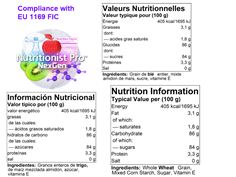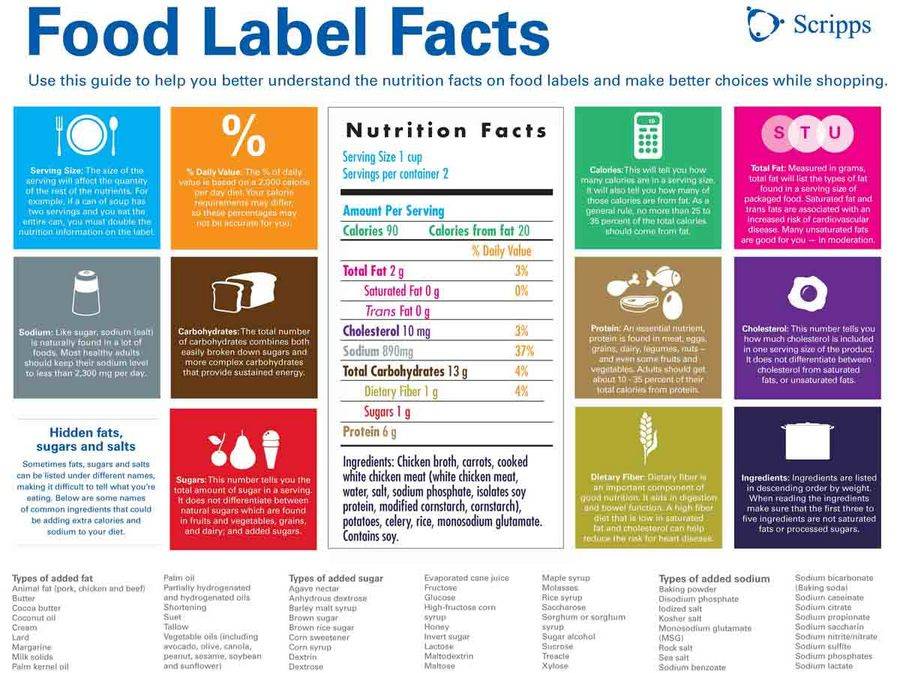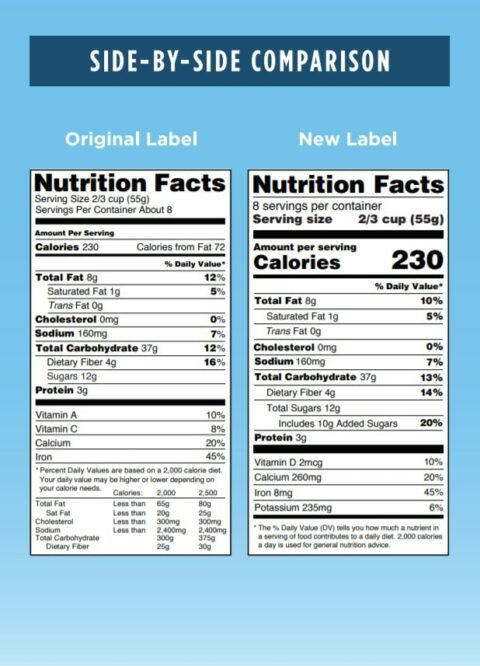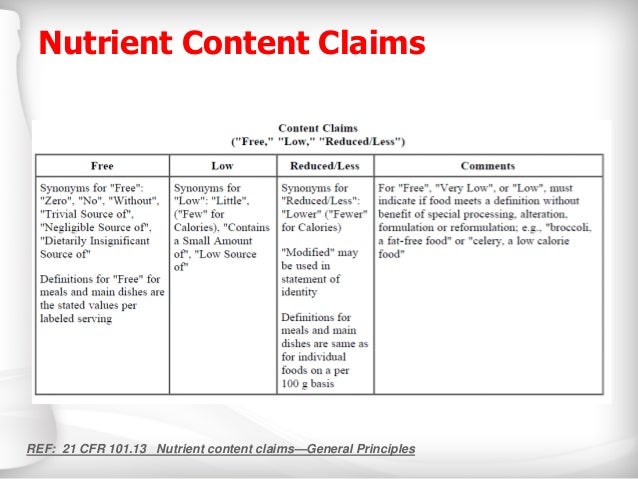41 nutrient content claims on food labels
Nutrition claims - Food Safety A claim that a food is high in omega-3 fatty acids, and any claim likely to have the same meaning for the consumer, may only be made where the product contains at least 0,6 g alpha-linolenic acid per 100 g and per 100 kcal, or at least 80 mg of the sum of eicosapentaenoic acid and docosahexaenoic acid per 100 g and per 100 kcal. eCFR :: 21 CFR 101.54 -- Nutrient content claims for "good source ... (B) Quantitative information comparing the level of the nutrient in the product per labeled serving with that of the reference food that it replaces (e.g., "Fiber content of white bread is 1 gram (g) per serving; (this product) 3.5 g per serving") is declared adjacent to the most prominent claim or to the nutrition label, except that if the ...
Reading Food Labels (for Parents) - Main Line Health Food labels provide nutrition information so you can make smart choices about the food you buy and serve your family. The U.S. Food and Drug Administration (FDA) and the U.S. Department of Agriculture (USDA) require labels on almost all packaged foods. The information usually is on the back or side ...

Nutrient content claims on food labels
Nutrient content claims - Canadian Food Inspection Agency Specific nutrient content claim requirements How to use the claims tables Energy and calorie claims Protein claims Fat claims Saturated fatty acid claims Trans fatty acid claims Omega-3 and omega-6 polyunsaturated fatty acid claims Cholesterol claims Sodium (salt) claims Potassium claims Carbohydrate and sugars claims Dietary fibre claims Regulating health claims on food labels using nutrient ... - PubMed Objective: Proposed Australian regulation of claims on food labels includes requirements for products carrying a health claim to meet nutrient profiling criteria. This would not apply to nutrition content claims. The present study investigated the number and healthiness of products carrying claims and the impact of the proposed regulation. Understanding Food Labels | The Nutrition Source | Harvard T.H. Chan ... Under the Food Allergen Labeling and Consumer Protection Act of 2004, eight major food allergens—milk, fish, tree nuts, peanuts, shellfish, wheat, eggs, and soybeans—are required to be listed in a "contains" statement near the Ingredients list if present in a food. An example would be "contains wheat, milk, and soy."
Nutrient content claims on food labels. The Effects of Nutrition Knowledge on Food Label Use: A Review of the ... One goal of nutrient content claims is to communicate the value or relative amount of a specific nutrient within a food product (e.g., good source of fiber, fat free, low calorie). ... Petrovici D, Fearne A, Nayga RM, Drolias D. Nutritional knowledge, nutritional labels, and health claims on food a study of supermarket shoppers in the south ... Food Labeling: Nutrient Content Claims; Alpha-Linolenic Acid ... To enable the public to comprehend the information provided in nutrient content claims and to understand the relative significance of that information in the context of the daily diet, as required by section 403(r)(2)(G)(iv) of the FD&C Act, qualifying ALA levels for nutrient content claims in food labeling must be based on a single nutrient ... Nutrient Content Claim "Light" - LabelCalc Basic Guidelines for Using the Nutrient Content Claim "Light". In order to use the term "light" on your label, your product has to comply with a few strict FDA guidelines. First, you must compare your product to a reference food that falls into the same category as yours. If your product is a "light" frozen yogurt, for instance, you ... Label Claims for Food & Dietary Supplements | FDA Among the claims that can be used on food and dietary supplement labels are three categories of claims that are defined by statute and/or FDA regulations: health claims, nutrient content claims,...
Label Claims for Conventional Foods and Dietary Supplements Nutrient Content Claims The Nutrition Labeling and Education Act of 1990 (NLEA) permits the use of label claims that characterize the level of a nutrient in a food (i.e., nutrient content claims)... Nutrition claims - Canada.ca There are two types of nutrition claims on foods: nutrient content claims and health claims. These claims must also follow certain rules from Health Canada to make sure that they are consistent and not misleading. These claims are optional and may be found on some food products. Nutrient content claims describe the amount of a nutrient in a food. Nutrient Content - an overview | ScienceDirect Topics A nutrient content claim either expressly or implicitly characterizes the level of a nutrient in a product (e.g., "high in vitamin C" or "low in sodium"). In general, nutrient content claims cannot be used in food labeling unless the claim is made in accordance with existing FDA regulations or an authoritative statement by a scientific body. Nutrition content claims and health claims - Food Standards Nutrition content claims are about the content of certain nutrients or substances in a food, such as 'low in fat ' or 'good source of calcium'. These claims need to meet certain criteria. For example, food with a 'good source of calcium' claim needs to contain at least the amount of calcium specified in the Standard. Health claims
Use of the Term Healthy on Food Labeling | FDA While FDA is considering how to redefine the term "healthy" as a nutrient content claim, food manufacturers can continue to use the term "healthy" on foods that meet the current regulatory... Nutrient Content Claim vs Health Claim - LabelCalc Nutrient content claims, which are commonly used on food labels, either refer to the amount of a nutrient in a product or compare the levels of a nutrient in that food to a similar reference food. When referring to the amount of a nutrient in a product, words such as "low," "free," and "high" are often used. Making a nutrient content claim on food labels - Food labels - Canadian ... Non-prepackaged products and prepackaged products exempted from showing a Nutrition Facts table are permitted to make nutrient content claims or other permitted nutrition-related statements or representations on either the label for the food and/or in an advertisement. However, if a claim is made by or for the manufacturer for a prepackaged ... Nutrient Content Claims on a Food Label - LabelCalc The food product nutrition content must meet the strict guidelines and parameters set forth by the FDA in order to accurately make these nutrient content claims on a food label. For a more in-depth look at nutrient content claims, download this PDF. A Quick Reference Summary of Parameters
Nutrient Claims on Food Labels - Truly Good Foods Nutrient Claims on Food Labels July 19, 2018 Nutrient claims describe the content of a food, including the amount of nutrients, calories, cholesterol or fiber, but not in exact amounts. Usually on the front of the food label, the nutrient claim provides a quick comparison between similar products.
Nutrient Content Claims | FDA Nutrient Content Claims. See Claims That Can Be Made for Conventional Foods and Dietary Supplements for definitions of claims. Final Rule: Food Labeling: Nutrient Content Claims; Alpha-Linolenic ...
Nutrient Claims on Food Labels | Home & Garden Information Center Sodium content cannot exceed 360 mg per serving for individual foods and 480 mg per serving for meal-type products. If a food is labeled "healthy" or makes a health claim, it cannot contain any nutrient that increases the risk for disease. It must contain no more than 20% of the DV per serving of total fat, saturated fat, cholesterol, or sodium.
Nutrient content claims: what they mean - Canada.ca Table of nutrient-content claims and what they mean. The food provides an amount of a nutrient that is so small it likely won't have any effect on your body. The food is processed/modified so that it contains at least 25% less of the nutrient when compared with a similar product. Contains no added fats or oils or added butter or ghee, or ...
Protein Label - LabelCalc The DV for protein is 50g, so the RACC of the food must contain over 10g of protein to have the "High in Protein" nutrient content claim. To have a nutrient content claim of a food being a "Good Source of Protein" the food must contain 10-19% of the DV per RACC, or 5 to 9.5g of protein per RACC. If you would like to have your food ...
Understanding Food Labels and Health Claims - Nutrition Essentials This label is called a Nutrition Facts panel, which gives information on the number of servings per container, the number of calories per serving, and certain nutrients. Specifically, it lists the macronutrients and four of the most important micronutrients people need to pay special attention to, such as Vitamin D, Calcium, Iron, and potassium.
Status of Nutrition Labeling, Health Claims, and Nutrient Content ... The Food and Drug Administration (FDA) conducts studies of food labels as part of its ongoing monitoring of the nutritional status of the US population. In 1994 FDA nutrition labeling rules were implemented and in 1997 the Food Label and Package Survey characterized various aspects of the labeling o …
Food Packaging Claims | American Heart Association "Nutrient content claims" are used for two purposes: To describe the level of a nutrient in the product using terms such as free, high, and low or To compare the level of a nutrient in a food to another food using terms such as more, reduced, and lite.
Food Labeling & Nutrition | FDA Food labeling is required for most prepared foods, such as breads, cereals, canned and frozen foods, snacks, desserts, drinks, etc. Nutrition labeling for raw produce (fruits and vegetables) and...
History of Nutrition Labeling - Front-of-Package Nutrition Rating ... Nutrients to be listed on nutrition labels included calories, calories from fat, total fat, saturated fat, cholesterol, sodium, total carbohydrate, dietary fiber, sugars, protein, vitamins A and C, calcium, and iron.
Understanding Food Labels | The Nutrition Source | Harvard T.H. Chan ... Under the Food Allergen Labeling and Consumer Protection Act of 2004, eight major food allergens—milk, fish, tree nuts, peanuts, shellfish, wheat, eggs, and soybeans—are required to be listed in a "contains" statement near the Ingredients list if present in a food. An example would be "contains wheat, milk, and soy."
Regulating health claims on food labels using nutrient ... - PubMed Objective: Proposed Australian regulation of claims on food labels includes requirements for products carrying a health claim to meet nutrient profiling criteria. This would not apply to nutrition content claims. The present study investigated the number and healthiness of products carrying claims and the impact of the proposed regulation.
Nutrient content claims - Canadian Food Inspection Agency Specific nutrient content claim requirements How to use the claims tables Energy and calorie claims Protein claims Fat claims Saturated fatty acid claims Trans fatty acid claims Omega-3 and omega-6 polyunsaturated fatty acid claims Cholesterol claims Sodium (salt) claims Potassium claims Carbohydrate and sugars claims Dietary fibre claims








Post a Comment for "41 nutrient content claims on food labels"